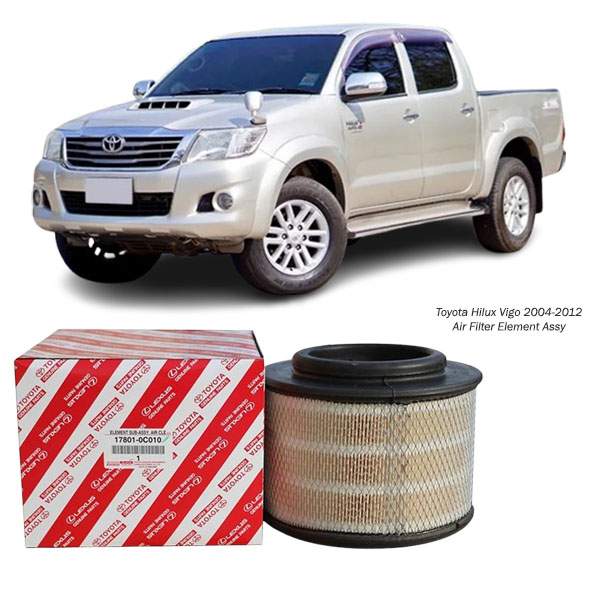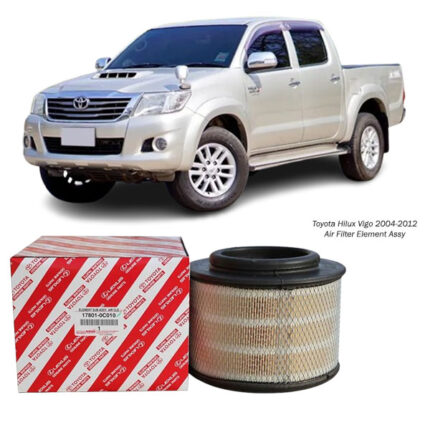-11%
Get Toyota Hilux Vigo 2004-2012 Air Filter Element Assy 17801-0C010 in Kenya
An Air Filter Element Assembly is a crucial component of your vehicle’s intake system. It plays an essential role in keeping the engine clean by filtering dust, dirt, and other contaminants from the air before it reaches the engine. This ensures smooth performance, optimal fuel efficiency, and extended engine life.
In this detailed guide, we’ll explore everything about air filter element assemblies, including their function, types, maintenance, and why they are essential for your vehicle.
What is an Air Filter Element Assembly?
The Air Filter Element Assembly is part of the engine’s air intake system, designed to trap impurities from the air before they enter the combustion chamber. The engine requires a precise mixture of air and fuel for efficient combustion, and a clean air filter ensures that only clean, debris-free air enters the system.
Without a properly functioning air filter, contaminants like dirt, dust, pollen, and even tiny metal particles could enter the engine, leading to poor performance, higher fuel consumption, and even costly damage.
How Does an Air Filter Work?
As your engine runs, it continuously draws in air for combustion. The air filter’s job is to:
-
Trap Impurities – Dust, debris, and contaminants are captured by the filter.
-
Ensure Clean Airflow – Only clean air is allowed into the engine.
-
Optimize Air-Fuel Mixture – Ensures the right balance of air and fuel for combustion.
-
Improve Engine Efficiency – Reduces wear and tear on internal components.
Key Benefits of an Air Filter:
Prevents engine damage caused by contaminants
Enhances fuel efficiency
Prolongs engine lifespan
Improves acceleration and performance
Reduces harmful emissions
Types of Air Filter Elements
Different air filters offer varying levels of filtration and durability. Here are the most common types:
1. Paper Air Filters
Most common type found in standard vehicles
Made from pleated paper that captures dirt and dust
Affordable and disposable
Requires regular replacement
2. Foam Air Filters
Made from polyurethane foam
Common in off-road and high-performance vehicles
Can be cleaned and reused multiple times
Requires oiling for enhanced filtration
3. Cotton Gauze Air Filters
Multi-layered cotton gauze construction
Washable and reusable
High-performance filtration with increased airflow
Ideal for sports and racing cars
4. Carbon Air Filters
Contains activated carbon to reduce odors and pollutants
Commonly used in cabin air filtration systems
Enhances air quality inside the vehicle
5. High-Efficiency Particulate Air (HEPA) Filters
Advanced filtration that captures microscopic particles
Commonly used in premium and electric vehicles
Improves air quality for drivers and passengers
Signs That Your Air Filter Needs Replacement
Over time, air filters get clogged with debris, which reduces their effectiveness. Here are some warning signs that indicate it’s time for a replacement:
Reduced Fuel Efficiency – A clogged filter restricts airflow, causing the engine to burn more fuel.
Poor Acceleration – If your car feels sluggish, a dirty air filter might be the cause.
Unusual Engine Noises – A restricted airflow can cause the engine to make unusual sounds.
Check Engine Light – Some vehicles detect restricted airflow and trigger a warning.
Black Smoke from Exhaust – An improper air-fuel mixture can lead to incomplete combustion.
Tip: It’s recommended to replace your air filter every 10,000 to 15,000 miles (16,000 to 24,000 km) or as specified by your vehicle’s manufacturer.
How to Replace an Air Filter?
Replacing an air filter is one of the easiest car maintenance tasks you can do. Follow these simple steps:
Step 1: Locate the Air Filter Box
The air filter box is usually found near the engine and is covered by a plastic or metal housing.
Step 2: Open the Filter Housing
Unclip or unscrew the cover to access the old filter.
Step 3: Remove the Old Filter
Carefully take out the old filter and inspect it for dirt and damage.
Step 4: Insert the New Filter
Place the new filter in the housing, ensuring it fits snugly.
Step 5: Secure the Housing and Close It
Reattach the cover and make sure everything is securely fastened.
Tip: Always choose a high-quality filter that matches your vehicle’s specifications for the best performance.
Benefits of a Clean Air Filter
A well-maintained air filter offers multiple advantages for your vehicle, including:
Better Engine Performance – Clean airflow improves combustion efficiency.
Increased Fuel Economy – A clean filter helps the engine run more efficiently.
Reduced Emissions – Clean air intake leads to fewer pollutants.
Longer Engine Life – Prevents contaminants from damaging internal engine components.
Lower Maintenance Costs – Regular replacements reduce the risk of expensive repairs.
Choosing the Right Air Filter for Your Car
When selecting an air filter, consider the following factors:
Vehicle Compatibility – Check your car’s manual for the correct filter size.
Filter Material – Choose between paper, foam, or cotton based on your driving needs.
Driving Conditions – If you drive in dusty areas, opt for a high-performance filter.
Brand & Quality – Invest in a reputable brand for durability and reliability.
FAQs About Air Filters
1. Can I Clean and Reuse My Air Filter?
Some filters, like foam and cotton gauze types, can be washed and reused. Paper filters, however, must be replaced.
2. How Often Should I Check My Air Filter?
It’s best to inspect your air filter every 3,000 to 5,000 miles or during regular vehicle servicing.
3. What Happens If I Don’t Replace My Air Filter?
A clogged air filter can lead to poor engine performance, higher fuel consumption, and even long-term damage.
4. Does a High-Performance Air Filter Improve Horsepower?
Yes! High-flow filters can improve airflow, slightly boosting horsepower and throttle response.
Follow us on Facebook for more parts.




